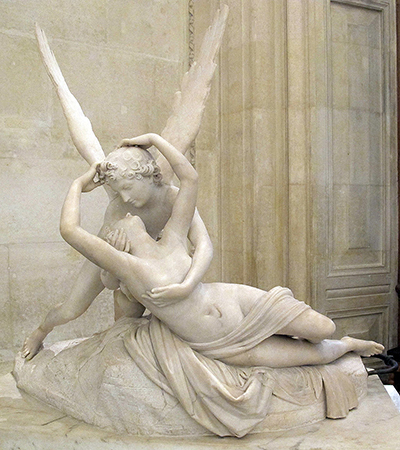Antonio Canova's sculpture, Psyche Revived by Cupid's Kiss, was inspired by a Roman painting that was found in Herculaneum during his visit to Naples in 1787.
The sculpture is considered a masterpiece of Neoclassical style but also has the mythological elements of emotional lovers, a clear sign of the emerging movement of Romanticism. The narrative follows that the winged male figure is that of god Eros or Cupid in Latin and is recognizable by his wings and the arrows in his quiver. The girl has been identified as Psyche. The plot has it that Cupid mother Venus, represented the goddess of beauty, commanded Psyche to bring back a flask, but strictly forbade her from opening it.
Out of curiosity, Psyche opened it and inhaled poisonous fumes that put her into a heavy, comalike sleep. When Cupid found her lying motionless, he touched her carefully with the tip of his arrow to see if she was still alive. This is the exact moment captured by the sculptor: He lifts his beloved Psyche in a tender embrace of love.
She also lets herself sink slowly backward, languorously taking her lover's head between her hands. The sculpture was designed perfectly and it can be looked at from different angles. The sculpture has a powerful impression of aliveness and shows remarkable subtlety and how he perfectly worked on the marble surface. Also visible are deliberately toothed chisel marks left on the rock surface. There are also a difference in texture between the folds of the fabric on the ground and the filmy muslin clinging to Psyches thighs.
The skin has a very smooth texture which was achieved by using a finer filling technique as can be clearly seen from Cupid's face. The flask is on a separate location and its particular polishing is highly likely from turning and use of polish powder. It must have been lustered, and without doubt, waxed to give it the look of a valuable metal.
Also, Cupid's wings were fixed in his back with such great accuracy. The wings are surprisingly thick and vivid, yet when backlit by the sun they become translucent, with a splendid golden hue. His father Pietro Canova, a stone cutter, had some impact on Antonio Canova's ambition in the art world. However, it was his paternal grandfather, Pasino Canova, who was a stonemason, owner of a quarry, and was a sculptor specializing in late Baroque style who had a profound influence on Antonio Canova. He led Antonio into professional sculpting art. Canova's other work includes Perseus Triumphant between 1804 to 1806, Napoleon as Mars the Peacemaker between 1802 to 1806, Venus Victrix 1805 to 1808, and The Three Graces between 1814 and 1817. He was also highly proficient in painting and drawing too, though he will always be remembered first and foremost as a sculptor.
Psyche Revived by Cupid's Kiss is just over a metre and a half in height. It was constructed entirely in marble, and this would become the preferred medium for Canova when working within the discipline of sculpture. There are two versions in existence, with the first creation now being found at the Louvre in Paris, with a followup piece on display in St Petersburg in Russia. It was common for this artist to produce several iterations of the same design, when working within sculpture. His original moulds can also be found too, and these hold a considerable value of their own.
The Louvre sculpture is believed to have been worked on between the years of 1787–1793, with the item then being sold at around the turn of the century just a few years later. It has remained within the collection of the Louvre since around 1824, though this is not unusual for the impressive art museum which has owned much of its collection of paintings and sculptures for several centuries. Some artists featured there would even visit the venue in their early years to study whatever was previously on display, underlining its role and impact across many centuries of art history.
Many art historians, as well as those who specialise more in ancient literature, have examined this sculpture in detail in order to be able to pinpoint and explain each feature added by Canova in the two versions. Canova was famous for drawing inspiration from literature from the past, and so the theme of Psyche Revived by Cupid's Kiss is entirely in line with the rest of his career. Cupid and Psyche comes directly from Lucius Apuleius' Latin novel The Golden Ass, which is also sometimes known as Metamorphoses. It was released in 1650 and inspired many painters and sculptors.
Cupid and Psyche alone have appeared in countless artistic oeuvres, including famous contributions from the likes of François Gérard, Raphael, Anthony van Dyck, Luca Giordano and Edward Burne-Jones to name just a few. In this example we find a young man with wings who lands besides a girl who lies motionless. His quiver with arrows helps to identify him as the god Eros, known by many as Cupid instead. Psyche is the girl lying besides him. The tale describes the importance of a small flask and this detail is features within the sculpture, though can only be seen from some angles.




